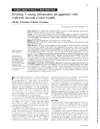Please use this identifier to cite or link to this item:
https://accedacris.ulpgc.es/jspui/handle/10553/48504
| Title: | Smoking in young adolescents: an approach with multilevel discrete choice models | Authors: | Pinilla Domínguez, Jaime González Lopez-Valcarcel, Beatriz Barber Pérez, Patricia Lucía Santana Jiménez, Yolanda |
UNESCO Clasification: | 531207 Sanidad | Keywords: | Tabaquismo Adolescentes |
Issue Date: | 2002 | Publisher: | 0143-005X | Journal: | Journal of Epidemiology and Community Health | Abstract: | Study objective: To understand the context for tobacco smoking in young adolescents, estimating the effects of individual, family, social, and school related factors. Design: Cross sectional analysis performed by multilevel logistic regression with pupils at the first level and schools at the second level. The data came from a stratified sample of students surveyed on their own, their families' and their friends' smoking habits, their schools, and their awareness of cigarette prices and advertising. Setting: The study was performed in the island of Gran Canaria, Spain. Participants: 1877 students from 30 secondary schools in spring of 2000 (model's effective sample sizes 1697 and 1738). Main results: 14.2% of the young teenagers surveyed use tobacco, almost half of them (6.3% of the total surveyed) on a daily basis. According to the ordered logistic regression model, to have a smoker as the best friend increases significantly the probability of smoking (odds ratio: 6.96, 95% confidence intervals (CI) (4.93 to 9.84), and the same stands for one smoker living at home compared with a smoking free home (odds ratio: 2.03, 95% CI 1.22 to 3.36). Girls smoke more (odds ratio: 1.85, 95% CI 1.33 to 2.59). Experience with alcohol, and lack of interest in studies are also significant factors affecting smoking. Multilevel models of logistic regression showed that factors related to the school affect the smoking behaviour of young teenagers. More specifically, whether a school complies with antismoking rules or not is the main factor to predict smoking prevalence in schools. The remainder of the differences can be attributed to individual and family characteristics, tobacco consumption by parents or other close relatives, and peer group. Conclusions: A great deal of the individual differences in smoking are explained by factors at the school level, therefore the context is very relevant in this case. The most relevant predictors for smoking in young adolescents include some factors related to the schools they attend. One variable stood out in accounting for the school to school differences: how well they enforced the no smoking rule. Therefore we can prevent or delay tobacco smoking in adolescents not only by publicising health risks, but also by better enforcing no smoking rules in schools. | URI: | https://accedacris.ulpgc.es/handle/10553/48504 | ISSN: | 0143-005X | DOI: | 10.1136/jech.56.3.227 | Source: | Journal of Epidemiology and Community Health[ISSN 0143-005X],v. 56, p. 227-232 |
| Appears in Collections: | Artículos |
SCOPUSTM
Citations
86
checked on Jun 8, 2025
WEB OF SCIENCETM
Citations
69
checked on Jun 8, 2025
Page view(s)
106
checked on Sep 7, 2024
Download(s)
124
checked on Sep 7, 2024
Google ScholarTM
Check
Altmetric
Share
Export metadata
Items in accedaCRIS are protected by copyright, with all rights reserved, unless otherwise indicated.
